Deprotonation Study guides, Class notes & Summaries
Looking for the best study guides, study notes and summaries about Deprotonation? On this page you'll find 40 study documents about Deprotonation.
Page 2 out of 40 results
Sort by
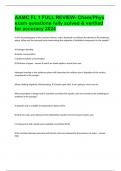
-
AAMC FL 1 FULL REVIEW- Chem/Phys exam questions fully solved & verified for accuracy 2024
- Exam (elaborations) • 24 pages • 2024
- Available in package deal
-
- $14.99
- + learn more
In the chromatography of the reaction mixture, water absorbed on cellulose functioned as the stationary phase. What was the principal factor determining the migration of individual components in the sample? A.Hydrogen bonding B.Solute concentration C.Stationary phase concentration D.Thickness of paper B and D are dumb options. Knock them out. hydrogen bonding to the stationary phase will determine the relative rate of migration of the various components in the sample. When thinking ...
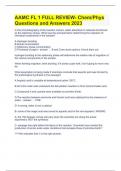
-
AAMC FL 1 FULL REVIEW- Chem/Phys Questions and Answers 2023
- Exam (elaborations) • 17 pages • 2023
-
Available in package deal
-
- $22.49
- + learn more
AAMC FL 1 FULL REVIEW- Chem/Phys Questions and Answers 2023 In the chromatography of the reaction mixture, water absorbed on cellulose functioned as the stationary phase. What was the principal factor determining the migration of individual components in the sample? A.Hydrogen bonding B.Solute concentration C.Stationary phase concentration D.Thickness of paper B and D are dumb options. Knock them out. hydrogen bonding to the stationary phase will determine the relative rate of migrati...
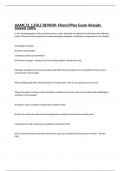
-
AAMC FL 1 FULL REVIEW- Chem/Phys Exam Already Solved 100%
- Exam (elaborations) • 25 pages • 2023
-
- $15.99
- + learn more
In the chromatography of the reaction mixture, water absorbed on cellulose functioned as the stationary phase. What was the principal factor determining the migration of individual components in the sample? A.Hydrogen bonding B.Solute concentration C.Stationary phase concentration D.Thickness of paper - Answer B and D are dumb options. Knock them out. hydrogen bonding to the stationary phase will determine the relative rate of migration of the various components in the sample. When...
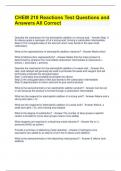
-
CHEM 210 Reactions Test Questions and Answers All Correct
- Exam (elaborations) • 3 pages • 2024
-
Available in package deal
-
- $8.49
- + learn more
CHEM 210 Reactions Test Questions and Answers All Correct Describe the mechanism for the electrophilic addition of a strong acid. - Answer-Step 1) An alkene grabs a hydrogen off of a strong acid, forming a carbocation intermediate. Step 2) The conjugate base of the acid (an anion now) bonds to the open shell carbocation What is the regioselectivity of electrophilic addition reactions? - Answer-Markovnikov What is Markovnikov regioselectivity? - Answer-States that the major product is d...
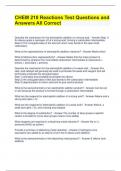
-
CHEM 210 Reactions Test Questions and Answers All Correct
- Exam (elaborations) • 3 pages • 2024
-
Available in package deal
-
- $7.59
- + learn more
CHEM 210 Reactions Test Questions and Answers All Correct Describe the mechanism for the electrophilic addition of a strong acid. - Answer-Step 1) An alkene grabs a hydrogen off of a strong acid, forming a carbocation intermediate. Step 2) The conjugate base of the acid (an anion now) bonds to the open shell carbocation What is the regioselectivity of electrophilic addition reactions? - Answer-Markovnikov What is Markovnikov regioselectivity? - Answer-States that the major product is d...
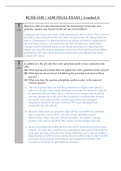
-
BCHE 5180 / 6180 FINAL EXAM | Graded A
- Exam (elaborations) • 18 pages • 2022
-
- $13.49
- + learn more
BCHE 5180 / 6180 FINAL EXAM | Graded A 1 3 points Based on what you have learned about the functioning of enzymes and proteins, explain why the pH in the cell has to be buffered. A large group of enzymes show a pH optimum for their activity. This value is normally close to the pH in the cell. When the pH in the cell changes this can lead to a protonation or deprotonation of an amino acid that is important for the enzymatic activity. As a result the activity will decrease. Upon large ch...
MCAT 101 EXAM 2 STUDY GUIDE 1. Explanation: This is an Analogy question. A: No. ...
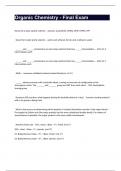
-
Organic Chemistry - Final Exam
- Exam (elaborations) • 7 pages • 2023
-
- $8.49
- + learn more
Organic Chemistry - Final Exam Name the 6 polar aprotic solvents - acetone, acetonitrile, DMSO, DMF, HMPA, THF Name the 5 polar protic solvents - acetic acid, ethanol, formic acid, methanol, water ______ and ______ mechanisms are two step reactions that have _____ intermediates. - SN1; E1; 2 Intermediates each ______ and ______ mechanisms are one step reactions that have _____ intermediates. - SN2; E2; 1 Intermediate each Allylic - resonance stabilized (carbon bonde...
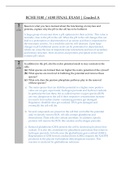
-
BCHE 5180 / 6180 FINAL EXAM | Graded A
- Exam (elaborations) • 18 pages • 2022
-
- $13.99
- + learn more
BCHE 5180 / 6180 FINAL EXAM | Graded A 1 3 points Based on what you have learned about the functioning of enzymes and proteins, explain why the pH in the cell has to be buffered. A large group of enzymes show a pH optimum for their activity. This value is normally close to the pH in the cell. When the pH in the cell changes this can lead to a protonation or deprotonation of an amino acid that is important for the enzymatic activity. As a result the activity will decrease. Upon large change...
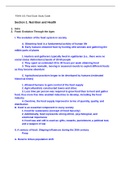
-
FSHN 101 Final Exam Study Guide | DOWNLOAD TO SCORE AN A
- Other • 105 pages • 2023
-
- $10.99
- + learn more
FSHN 101 Final Exam Study Guide Section 1: Nutrition and Health 1. Intro 2. Food: Evolution Through the Ages I. The evolution of the food system in society A. Obtaining food is a fundamen tal activity of human life B. Early humans obtained food by hunting wild animals and gathering the edible parts of plants 1. Hunters and gatherers typically lived in egalitarian (i.e., there were no social status distinctions) bands of 20-50 people 2. They spent an estimated 20 to 30 hours per week obtaining fo...

Do you wonder why so many students wear nice clothes, have money to spare and enjoy tons of free time? Well, they sell on Stuvia! Imagine your study notes being downloaded a dozen times for $15 each. Every. Single. Day. Discover all about earning on Stuvia



